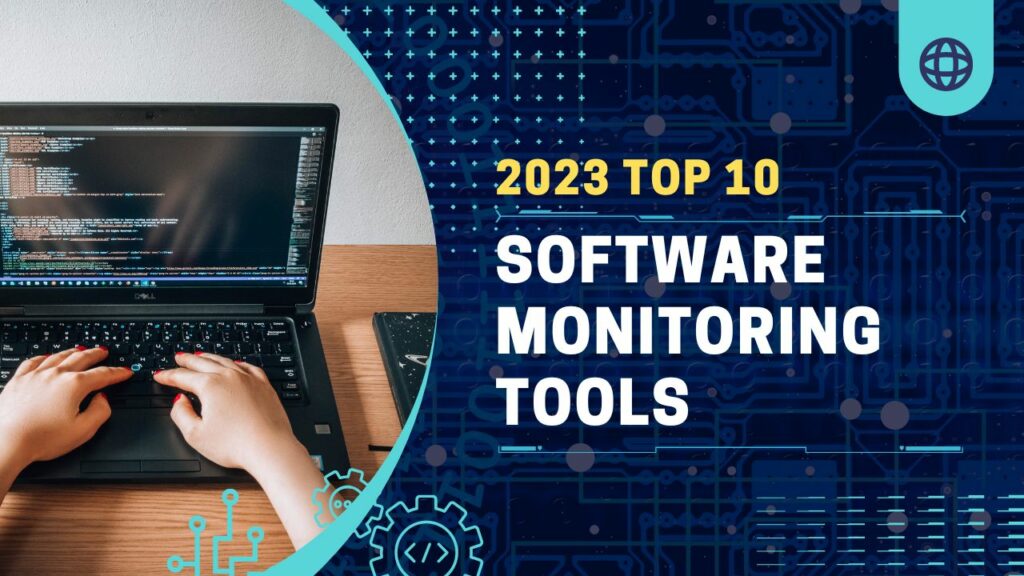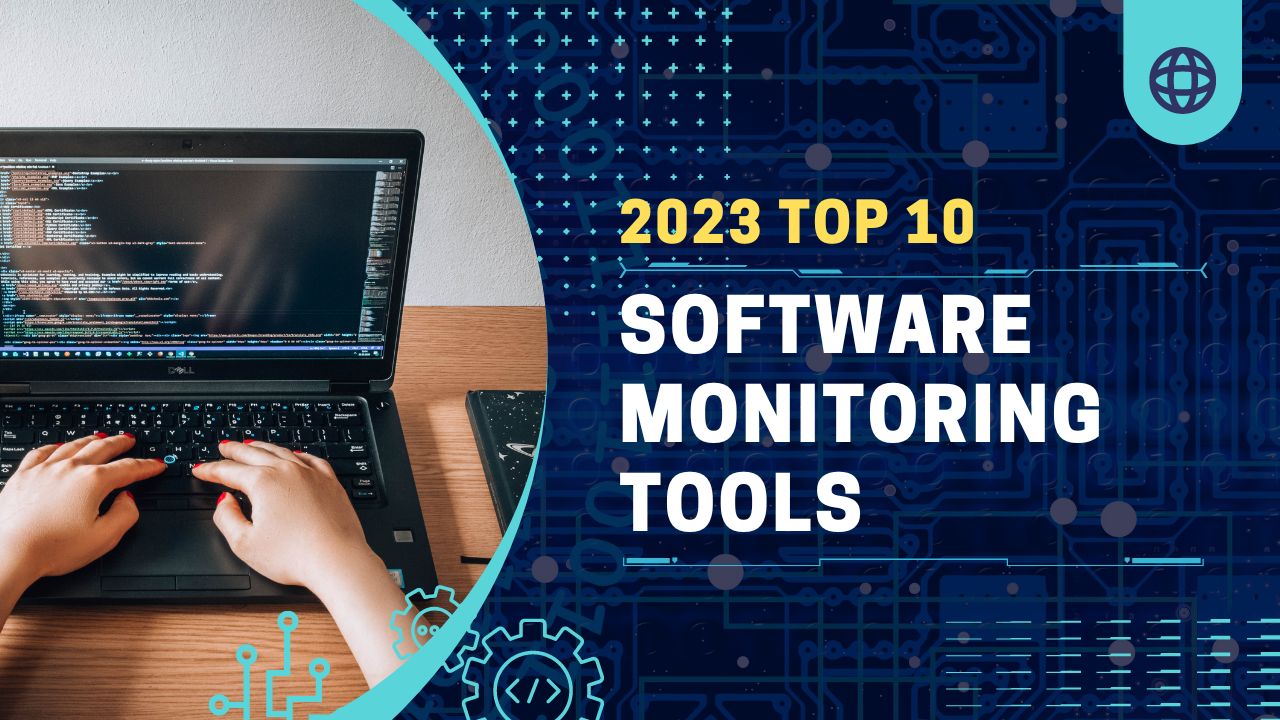 In today’s fast-paced digital landscape, effective software monitoring is essential for businesses to ensure optimal performance and identify potential issues. That’s why we’ve compiled a comprehensive list of the best software monitoring tools available, designed to empower organizations with real-time insights and proactive problem-solving capabilities. From performance tracking to error detection, find the perfect solution to streamline your operations and deliver exceptional user experiences.
In today’s fast-paced digital landscape, effective software monitoring is essential for businesses to ensure optimal performance and identify potential issues. That’s why we’ve compiled a comprehensive list of the best software monitoring tools available, designed to empower organizations with real-time insights and proactive problem-solving capabilities. From performance tracking to error detection, find the perfect solution to streamline your operations and deliver exceptional user experiences.
What Is a Server Monitoring Software?
Server monitoring software is a tool or application used to monitor the performance and health of servers within a network. It gives admins real-time visibility into the server architecture, allowing them to track numerous parameters and metrics to ensure the servers are operating at peak performance.
Typically, server monitoring software collects data on important performance indicators such as CPU usage, memory utilization, disk space, network traffic, and other critical system parameters. It can also monitor specific server applications, services, and processes.
Organizations can use server monitoring software to proactively monitor their server infrastructure, spot possible issues before they affect users or services, maximize resource usage, and guarantee the general stability and dependability of their systems.
What makes the best software monitoring tools?
The finest server monitoring software frequently shares numerous key features and qualities that enable them to manage and monitor server infrastructure effectively.
Here are some of the aspects that influence the quality of monitoring tools:
- Comprehensive Monitoring Capabilities: The top monitoring solutions cover and monitor a wide range of servers, operating systems, applications, and network devices.
- Real-time Monitoring and Alerts: Effective monitoring systems provide real-time monitoring capabilities to continuously track server performance and metrics.
- Configurable Dashboards and Reports: Monitoring systems should have configurable dashboards and reports that allow administrators to view key metrics and performance indicators that are appropriate for their needs.
- Scalability and Flexibility: The best monitoring tools are built to easily scale and manage big server settings.
- Ease of Use and Setup: User-friendly interfaces and easy configuration processes add to monitoring tools’ usability.
Best software monitoring tools
The “best” tool will vary depending on your unique monitoring requirements and the working environment. Consider variables like your environment’s specific needs, the tool’s scalability, usability, integration potential, degree of support, and user community when choosing the best software monitoring solution for your requirements. The best software monitoring tools are listed below.
1. Sematext Monitoring

Sematext, a company that specializes in log management, monitoring, and observability tools, offers a comprehensive monitoring solution known as Sematext Monitoring. Sematext Monitoring offers an extensive system for monitoring the performance and health of applications, infrastructure, and microservices in real time.
Key Features:
- Enables the monitoring of programs written in a variety of programming languages, including Java, Python, Node.js, Ruby, and others
- Gives you the ability to trace and analyze requests as they move through various services and components of your application using distributed tracing capabilities
- Delivers real-time alerts via a variety of channels, like email, Slack, PagerDuty, or webhooks, to make sure you are informed as soon as problems arise
- Incorporates widely used frameworks and technologies, such as Docker, Kubernetes, AWS, Azure, Google Cloud, and many others
- Use machine learning techniques to find abnormalities in your metrics and logs automatically, assisting you in proactively identifying unusual activity and potential problems
2. ManageEngine OpManager
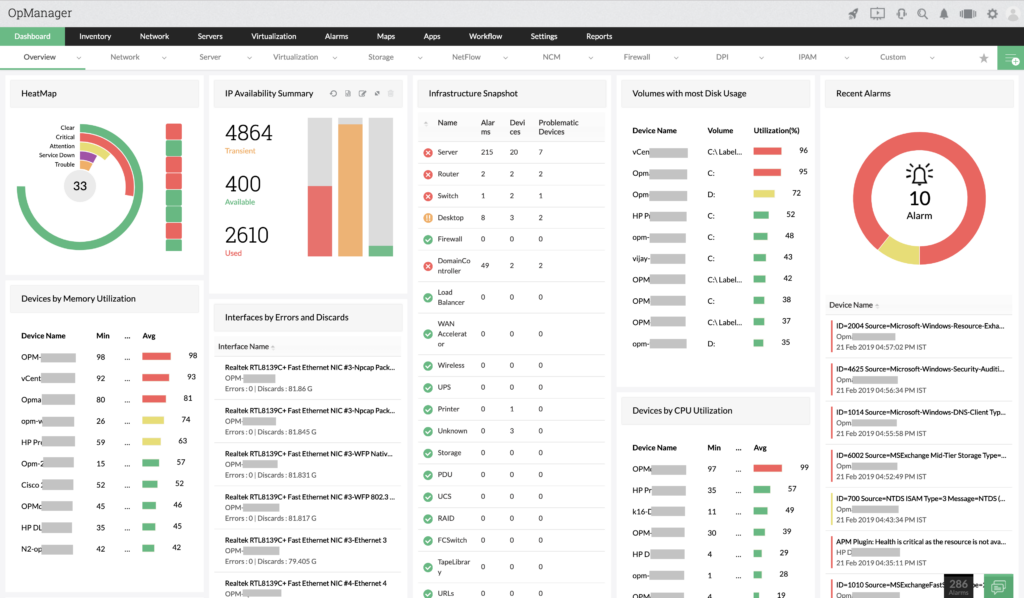
ManageEngine, a part of Zoho Corporation, created OpManager, a network and infrastructure monitoring tool. IT managers and network operations teams may monitor the performance, availability, and overall condition of their network devices, servers, apps, and services with the use of OpManager’s comprehensive monitoring capabilities.
Key Features:
- Provides real-time monitoring of network devices, including wireless access points, routers, switches, firewalls, and more
- Enables internal and external monitoring of apps, services, and protocols to make sure they are operating as intended
- Creates reports and offers historical information for capacity planning, performance analysis, and trend detection
- Permits network devices and servers to be monitored and managed remotely
- Incorporates security features such as secure communication protocols, audit logs, and role-based access control (RBAC)
3. Prometheus and Grafana

Grafana and Prometheus are two popular open-source technologies that are frequently used in conjunction with one another to monitor and visualize metrics in contemporary information technology systems.
Key Features:
- Offers a variety of data collecting methods such as HTTP-based scraping, service discovery, and custom client libraries for instrumenting apps
- Allows automatic service discovery, allowing it to identify and monitor new services as they are added or withdrawn from the environment on a dynamic basis
- Supports templating and variables, allowing for dynamic metric filtering and grouping
- Has a thriving plugin ecosystem that adds new data sources, panel types, and connectors
4. Zabbix

A robust and well-liked open-source server and network monitoring tool is Zabbix. It offers network, server, application, and service monitoring and alerting features. Zabbix is renowned for its extensibility, scalability, and robustness. It offers a complete set of tools for server and network monitoring and is appropriate for situations ranging in size from small to large. However, compared to certain other monitoring systems, setting up and customizing Zabbix may require more technical know-how.
Key Features:
- Enables flexibility in monitoring various types of systems by supporting both agent-based and agentless monitoring
- Supports a variety of monitoring techniques, such as SNMP, JMX, IPMI, ICMP pings, and custom scripts
- Offers configurable and versatile alerting features
- Provides a configurable web-based interface with extensive reporting options and dashboards
- Aids in finding the causes of accidents and efficiently controlling them
- Allows for distributed monitoring, enabling the setup of numerous Zabbix
- Has a vibrant and helpful community that supports its growth and offers extra resources and plugins
5. SolarWinds Server & Application Manager
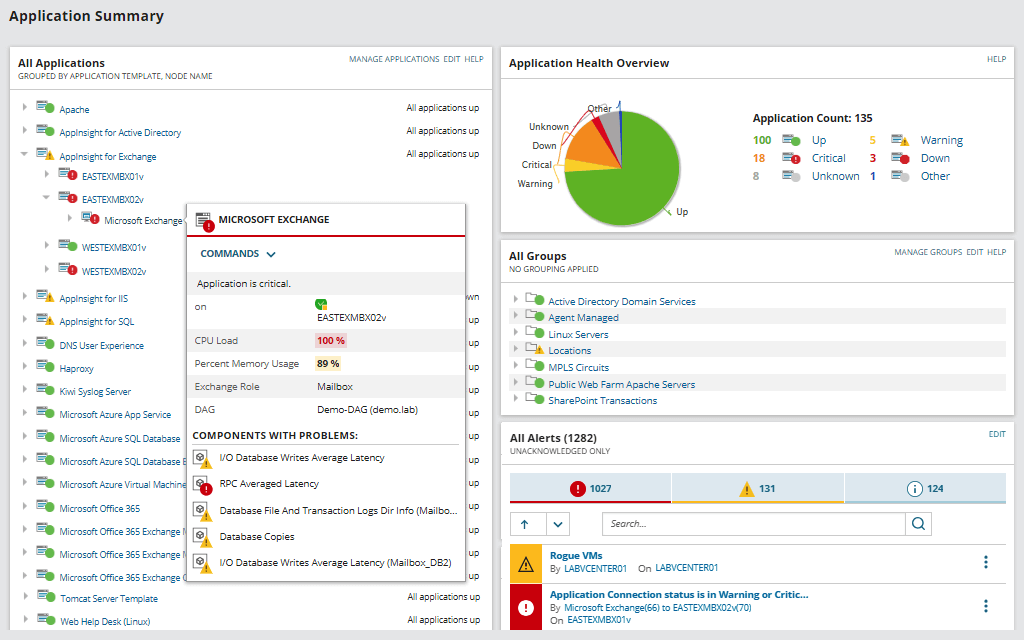
SolarWinds’ Server & Application Monitor (SAM) is a complete monitoring solution. SAM can monitor the performance, availability, and health of physical and virtualized servers, applications, and services. It provides many capabilities to assist IT administrators and operations teams in proactive infrastructure management.
Key Features:
- Allows you to monitor the health of your server’s hardware, including CPU usage, memory utilization, disk health, and network interface statistics
- Allows for the monitoring of applications, services, and processes
- Provides infrastructure monitoring for network devices, storage devices, virtualization platforms, and cloud environments
- Offers alerting tools that allow managers to be notified when predetermined thresholds or circumstances are exceeded
- Provides customizable dashboards and reporting tools for visualizing and analyzing monitored data
6. Site24x7
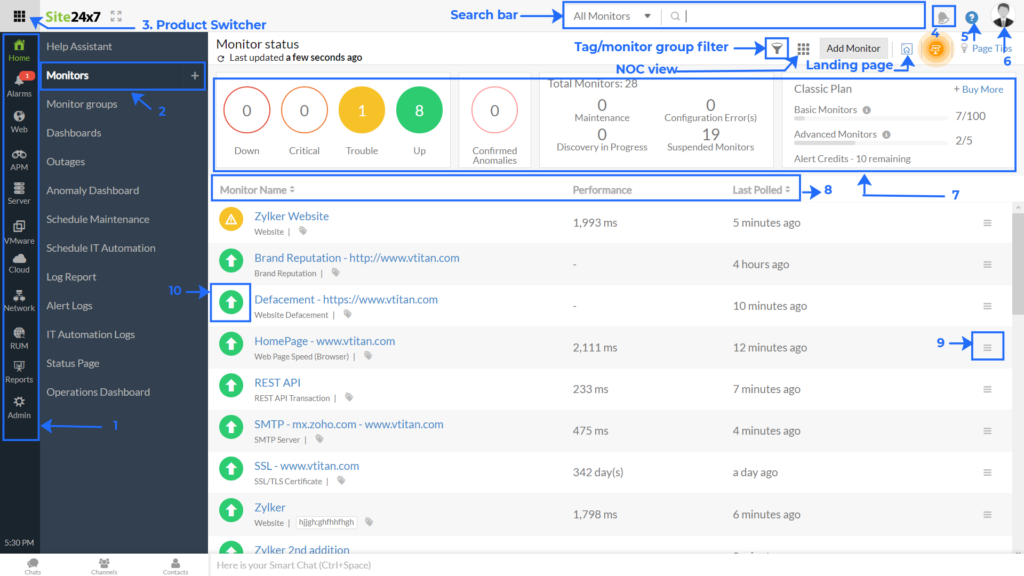
Zoho Corporation’s Site24x7 is a complete cloud-based monitoring system. It provides a comprehensive set of monitoring tools to assist businesses in monitoring the performance, availability, and user experience of websites, applications, servers, network devices, and cloud infrastructure.
Key Features:
- Allows you to track the availability and performance of websites and online apps from all around the world
- Provides APM tools for monitoring web applications and API performance
- Offers tools for synthetic monitoring to replicate user interactions with websites and applications
- Provides bespoke dashboards and reporting features for visualizing and analyzing monitoring data
- Interfaces with a wide range of third-party solutions, such as incident management, IT service management, and collaboration platforms
7. Dynatrace
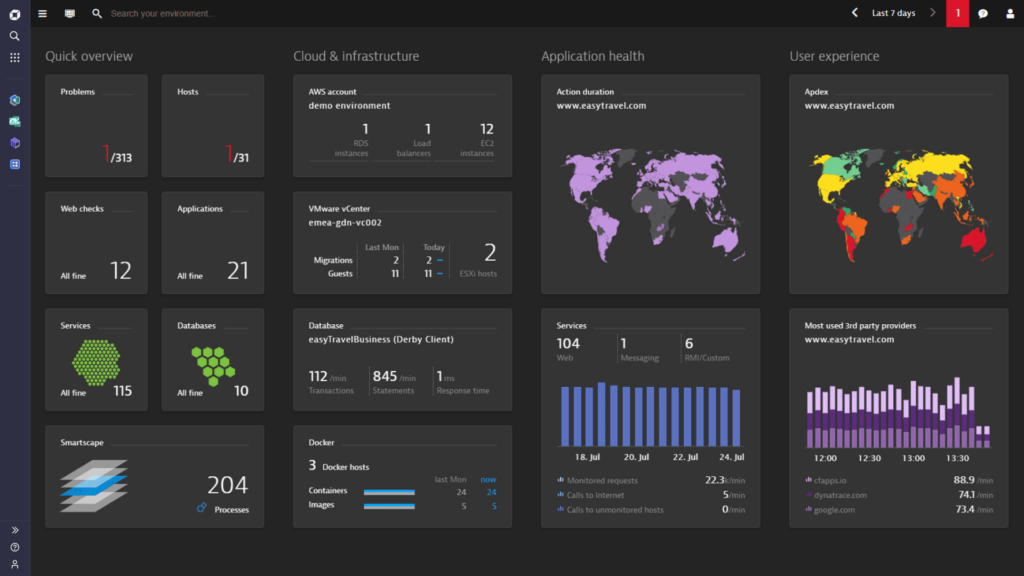
Dynatrace is a platform for advanced observability and application performance monitoring (APM). It delivers real-time visibility into the health and performance of complex cloud-native environments, apps, microservices, and infrastructure components. Dynatrace offers AI-powered automation and insight to assist enterprises in optimizing their digital ecosystems and providing excellent user experiences.
Key Features:
- Provides full-stack observability, giving insight into every component of the application stack, from infrastructure to code-level details
- Uses artificial intelligence and machine learning to find and analyze performance anomalies and dependencies automatically
- Optimizes application performance by tracking response times, faults, and resource consumption
- Gives you insight into resource use, scalability, and cloud service integrations
- Gives information on user paths, conversion rates, and customer behavior analysis
8. Better Stack

Better Stack provides an observability platform that is far more advanced. It is an integrated product that incorporates monitoring, log management, observability dashboards, issue management, and status pages all into one cohesive whole.
Key Features:
- Integrates management of incidents and scheduling of on-call shifts
- Has built-in custom domain status pages for Slack, Teams, Heroku, Amazon Web Services, and more than a hundred other integrations
- Provides excellent manuals and info for the community
- Contains gog management and observability dashboards
9. Datadog
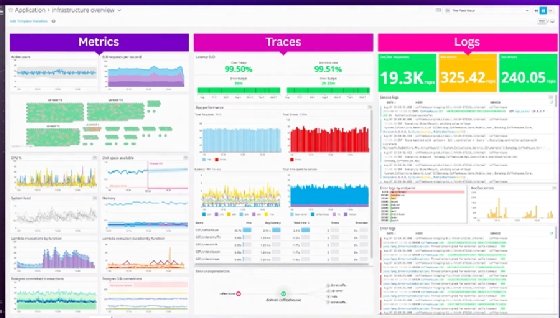
Datadog, a widely-used monitoring and analytics platform, is employed by organizations to obtain insight into their infrastructure, applications, and services. The platform offers functionalities and resources aimed at aiding in the monitoring, identification, and resolution of issues, as well as the enhancement of the efficiency of intricate distributed systems.
Key features:
- Assists you in proactively addressing issues and reducing downtime
- Provides configurable dashboards and visualizations for your monitoring data display and analysis
- Enables data and insight sharing between teams, and it supports several APIs for automation and custom connections
- Automatically detects anomalies and strange trends in your monitoring data using machine learning methods
- Give information on user behavior, network traffic, and potential security threats
10. PRTG Network Monitor
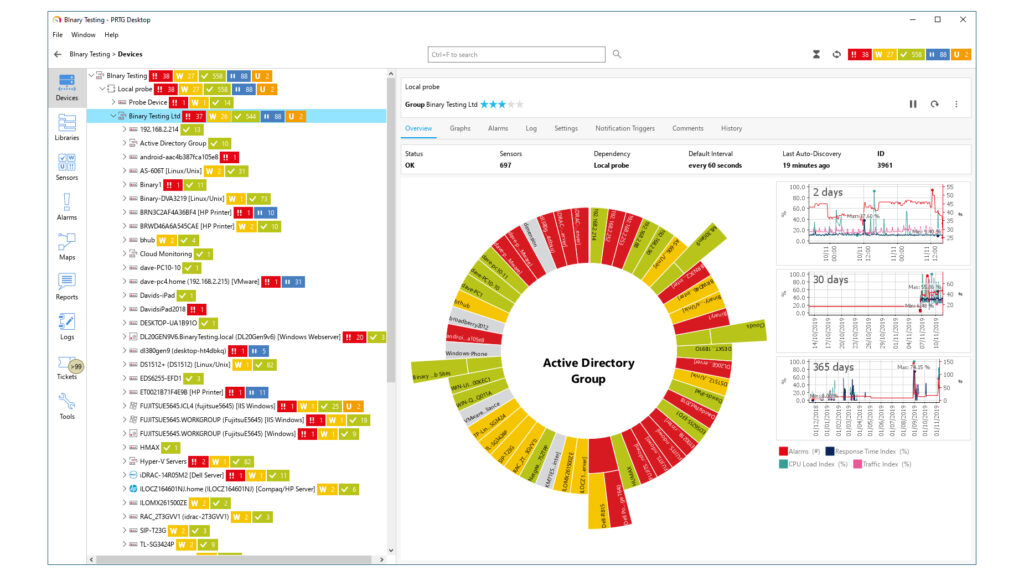
Paessler AG created PRTG Network Monitor, a complete network monitoring and management solution. It can assist network operators and IT managers in keeping track of the functionality and performance of their network infrastructure.
Key Features:
- Gives current information on latency, bandwidth utilization, and other performance indicators
- Uses a sensor-based methodology, with a sensor serving as a representation of each monitored element
- Allows you to create individualized alerts and notifications depending on predetermined criteria or circumstances
- Provides network mapping features to see your network’s connectivity and structure
- Storing previous monitoring data enables you to examine patterns and trends across time
What are the 3 types of monitoring?
The three primary types of infrastructure monitoring tools in the context of technological systems are reactive monitoring, proactive monitoring, and predictive monitoring. These three kinds of monitoring represent a continuum of escalating proactive and anticipatory system management approaches. Organizations work to use proactive and predictive monitoring solutions to reduce downtime, boost system performance, and increase overall reliability, even if reactive monitoring is essential for incident response.
Reactive Monitoring
Its primary objective is to identify and address issues and incidents as they arise. When predetermined thresholds or circumstances are violated, reactive monitoring uses alerts and notifications to start actions. Even while post-event reactive monitoring is crucial for incident response, it can take longer to respond to incidents and cause more downtime.
Proactive Monitoring
It entails continuously monitoring important metrics, performance indicators, and logs to spot potential issues and take appropriate preventative measures. This aids in spotting early warning signals and patterns that could point to declining system health or upcoming issues. Proactive monitoring helps minimize downtime, improve performance, and improve overall system stability by addressing possible issues before they arise.
Predictive Monitoring
Predictive monitoring goes beyond proactive monitoring. Detect prospective issues or performance bottlenecks, it includes evaluating huge amounts of monitoring data, spotting trends, and applying predictive models. To prevent downtime or service interruptions, administrators can allocate resources proactively and take preventive action thanks to predictive monitoring, which offers insights into potential upcoming issues.
What are the best monitoring tools for a start-up company?
For a startup company, having access to various monitoring tools can prove to be highly advantageous. When it comes to selecting the optimal monitoring tool, there are several factors to consider, including budget, specific needs and requirements, technology stack, scalability, and ease of use. When it comes to monitoring tools for startup companies, Datadog and PRTG Network Monitor are often highly recommended.
What’s a good monitoring software for home servers?
For those seeking to monitor their home servers, there are several software options available that are well-suited for small-scale environments. These include PRTG Network Monitor, Zabbix, Nagios XI, and Netdata. The following options serve as an excellent foundation for monitoring home servers. When it comes to choosing the right monitoring software for your needs, there are several factors to consider. These include ease of use, compatibility with your server setup, available features, and community support. By taking these factors into account, you can ensure that you select a monitoring solution that meets your specific requirements and helps you keep your systems running smoothly.
Best open-source monitoring tool?
Prometheus and Grafana, Zabbix, Nabgios Core, and Sensu Go are among the top open-source monitoring tools available. Open-source monitoring tools are highly sought after in the tech industry due to their active communities, comprehensive documentation, and diverse feature sets. Selecting the optimal tool is contingent upon your distinct needs, existing infrastructure, and personal inclinations. To determine the optimal monitoring solution for your requirements, it is advisable to assess and experiment with several alternatives.

